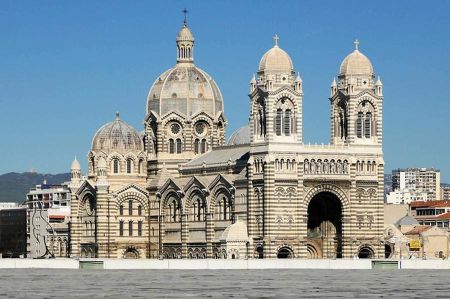Marseille Cathedral – an impressive building
- Written by Portal Editor
Right at the beginning of our stay in Marseille, we set off from our accommodation for an initial exploration tour towards the Vieux Port and passed the Marseille Cathedral, which was hard to miss.
Our first visit was brief, as the cathedral was closed shortly afterwards due to the late hour. Nevertheless, the following day we were happy to have used the few minutes of remaining opening time to take a few photos, because the number of visitors the next day was enormous, so we decided not to get into the crowd.
The ruins of the original Vieille Major just next door
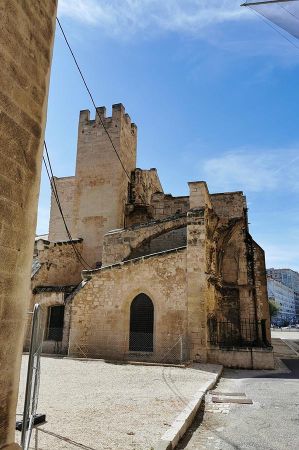 The cathedral, in French Cathédrale Sainte-Marie-Majeure de Marseille, but usually called Cathédrale de la Major, is the episcopal church of the Roman Catholic Archdiocese of Marseille.
The cathedral, in French Cathédrale Sainte-Marie-Majeure de Marseille, but usually called Cathédrale de la Major, is the episcopal church of the Roman Catholic Archdiocese of Marseille.
The monumental neo-Romanesque-Byzantine church, built in 1852, stands on the western edge of the old town above the Quai de la Joliette.
As already mentioned, the crowd of visitors rushing into the cathedral seemed too large for us to go in at this point.
We turned to the right, because there were the few ruins of the previous building, because at the turn of the 4th and 5th centuries there was already an east-facing episcopal church with a baptistery on the site of today's north-facing cathedral.
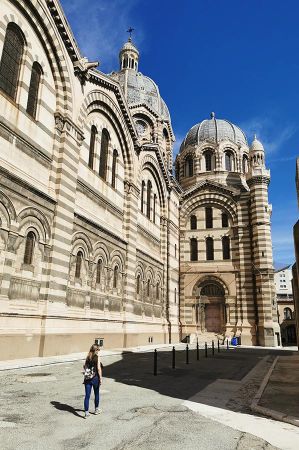 The foundations of this equally powerful complex were excavated during the construction of the Nouvelle Major and were partly used.
The foundations of this equally powerful complex were excavated during the construction of the Nouvelle Major and were partly used.
The church originally bore the patronage of St. Lazarus, but was only mentioned as St. Mary's Church since the time of Charlemagne.
It was destroyed in three Saracen raids, most recently in 923, and then restored.
Nevertheless, it was so dilapidated at the time of Bishop Pons II that he undertook a completely new building in the year of his death in 1073.
The Romanesque cathedral of the 11th century was a three-aisled basilica with a rectangular floor plan, which included a main and two secondary apses. It originally had five nave bays.
Napoleon III lays the symbolic foundation stone for the new building
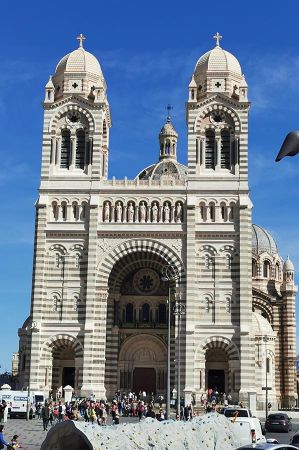 The two western ones with the main portal were demolished in the High Middle Ages to make room for new city fortifications, possibly because the sea surf had broken off part of the bank.
The two western ones with the main portal were demolished in the High Middle Ages to make room for new city fortifications, possibly because the sea surf had broken off part of the bank.
The portal was moved to the south side of the nave. This was followed by the addition of several chapels and a sacristy.
The choir was flanked by two square towers, of which the southern one, called the Tour de l'Évêché, has been preserved in its 19th century design
During the French Revolution, the diocese of Marseille was abolished, the cathedral was demoted to a parish church and later temporarily closed.
The bells were melted down, the sculptures were destroyed, and the historical furnishings were sold.
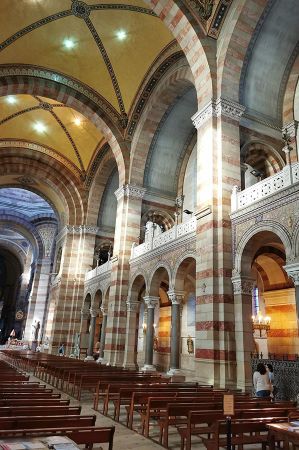 The building suffered severe damage, which was partly exacerbated by conservation measures in the early 19th century.
The building suffered severe damage, which was partly exacerbated by conservation measures in the early 19th century.
In 1823 the poorly restored Vieille Major became an episcopal church again. In 1852 Napoleon III visited. Marseilles.
At the request of Bishop Charles Joseph Eugène de Mazenod, he symbolically laid the foundation stone of the new building.
In order to make space for the new building, two additional western bays of the Romanesque church and part of the extensions were demolished and the rest secured.
On the sea side, a large terrace with arched substructures was created for foundations.
The Cathédrale Sainte-Marie-Majeure de Marseille today
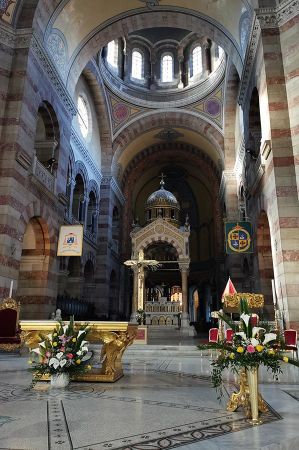 The new cathedral was then built and equipped over four decades, the cost of which far exceeded the original plans and the mosaics were never completed, which is a great shame.
The new cathedral was then built and equipped over four decades, the cost of which far exceeded the original plans and the mosaics were never completed, which is a great shame.
Unfortunately, far too little attention is paid to floor mosaics today. After these findings, we decide to come back to the cathedral in the evening, when the number of visitors noticeably decreases.
Today's St. Mary's Cathedral in Marseille is a three-aisled gallery basilica 141 m long with a 50 m wide transept and a crossing dome 60 m high. The transept arms and the elongated ambulatory also have domes.
The building was designed by Léon Vaudoyer and Henri-Jacques Espérandieu.
When it was completed in 1896, it was given the title of minor basilica.
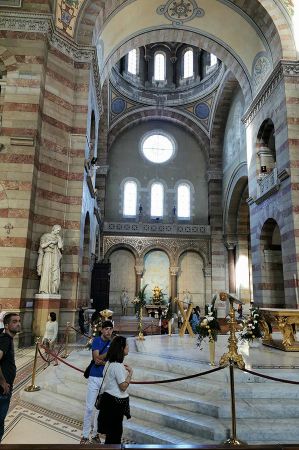 Above all, they create the overall Byzantine impression.
Above all, they create the overall Byzantine impression.
The apse is surrounded by a ring of chapels.
At the top of the apse is the Lady Chapel with the grave of Bishop Mazenod, who was canonized in 1995; it also has a dome.
The choir is flanked by the Sacred Heart and Lazarus Chapels.
The western building - geographically in the south - is designed as a portal bar with a high central arch, two attached bell towers crowned with domed hoods and rich sculptural decoration.
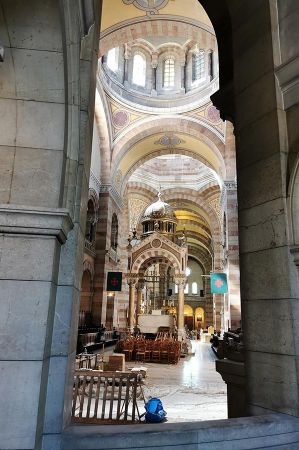 The defining design elements of the entire building are the striped alternation of light and dark stone as well as the combination of round arches with triangular gable roofs.
The defining design elements of the entire building are the striped alternation of light and dark stone as well as the combination of round arches with triangular gable roofs.
The interior also gets its effect from the domes and arches built in the Byzantine style and the changing colours of the stone layers.
Galleries are built into the three bay arches of the nave, which are supported by massive pillars and are each supported by two slender columns.
The choir and crossing area are decorated with figurative and ornamental mosaics.
The rest of the architectural decoration is rather sparse; he fell behind plans.
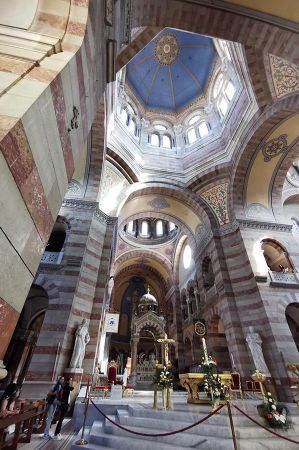 In the main line of sight is the large neo-Romanesque altar ciborium with the original high altar. In front of it is the post-conciliar altar island in the choir arch.
In the main line of sight is the large neo-Romanesque altar ciborium with the original high altar. In front of it is the post-conciliar altar island in the choir arch.
The effectively placed sculptures in the main room and in the chapels are high-quality works from the late 19th century.
Once again it is impressive how much financial effort went into building a place of worship here.
And as always, the question arises in our minds as to whether such pomp and splendor is really compatible with the meaning of a religion, a question that unfortunately arises again and again given all the misery in this world.
Please read as well:
Busking – a little stopover at the port of Marseille
Cycling hike to Wiehe with a stopover at St. Ursula
-
 Cathédrale Sainte-Marie-Majeure de Marseille
Cathédrale Sainte-Marie-Majeure de Marseille
Cathédrale Sainte-Marie-Majeure de Marseille
Cathédrale Sainte-Marie-Majeure de Marseille
-
 Cathédrale Sainte-Marie-Majeure de Marseille
Cathédrale Sainte-Marie-Majeure de Marseille
Cathédrale Sainte-Marie-Majeure de Marseille
Cathédrale Sainte-Marie-Majeure de Marseille
-
 Cathédrale Sainte-Marie-Majeure de Marseille
Cathédrale Sainte-Marie-Majeure de Marseille
Cathédrale Sainte-Marie-Majeure de Marseille
Cathédrale Sainte-Marie-Majeure de Marseille
-
 Cathédrale Sainte-Marie-Majeure de Marseille
Cathédrale Sainte-Marie-Majeure de Marseille
Cathédrale Sainte-Marie-Majeure de Marseille
Cathédrale Sainte-Marie-Majeure de Marseille
-
 Cathédrale Sainte-Marie-Majeure de Marseille
Cathédrale Sainte-Marie-Majeure de Marseille
Cathédrale Sainte-Marie-Majeure de Marseille
Cathédrale Sainte-Marie-Majeure de Marseille
-
 Cathédrale Sainte-Marie-Majeure de Marseille
Cathédrale Sainte-Marie-Majeure de Marseille
Cathédrale Sainte-Marie-Majeure de Marseille
Cathédrale Sainte-Marie-Majeure de Marseille
-
 Cathédrale Sainte-Marie-Majeure de Marseille
Cathédrale Sainte-Marie-Majeure de Marseille
Cathédrale Sainte-Marie-Majeure de Marseille
Cathédrale Sainte-Marie-Majeure de Marseille
-
 Cathédrale Sainte-Marie-Majeure de Marseille
Cathédrale Sainte-Marie-Majeure de Marseille
Cathédrale Sainte-Marie-Majeure de Marseille
Cathédrale Sainte-Marie-Majeure de Marseille
-
 Cathédrale Sainte-Marie-Majeure de Marseille
Cathédrale Sainte-Marie-Majeure de Marseille
Cathédrale Sainte-Marie-Majeure de Marseille
Cathédrale Sainte-Marie-Majeure de Marseille
https://www.alaturka.info/en/france/marseilles/6625-marseille-cathedral-an-impressive-building#sigProIdf249a9b2ce
